Uber Founder Travis Kalanik - “Silicon Valley Elite Rebel”
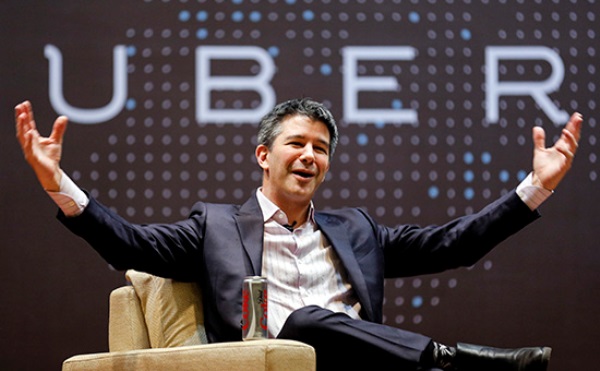
The founder and CEO of Uber taxi service Travis Kalanik will visit Russia for the first time .
Kalanik will arrive in Moscow on Sunday June 5 and in the evening of the same day will deliver a lecture at the Strelka Institute of Media and Design, dedicated to the development of transport in the 21st century. Kalanik will tell the audience “whether car sharing and improved public transport will be able to supplant private cars, and whether hybrid and electric cars will replace the usual gasoline and diesel ones,” the Strelka website said in a statement.
The Uber Private Driver Call Service is the fastest growing company in history. Uber raised $ 3.5 billion from the Saudi Arabian state fund. According to estimatesThe Wall Street Journal, an estimate of the world's most expensive startup, is close to $ 68 billion.
By his 39 years, Kalanik has become one of the richest entrepreneurs with a fortune of $ 6.2 billion. The personality of the founder of Uber causes a controversial reaction both among the public and among people who know him personally: some hate him, and some admire him.
Happy business childhood
Travis Kalanick grew up in the Northridge area on the outskirts of Los Angeles. He has a brother who became a firefighter, and two stepsisters. My father worked as an engineer, my mother sold ads in the Los Angeles Daily News. As a child, Kalanik dreamed of becoming a spy. What would be his path in this field is unknown. But no one will argue that Travis has had the makings of a seller since childhood. In school, he already walked up the porches and sold Cutco knives.
“I had a feeling that he was constantly trying to sell me something,” recalls classmate Kalanika. Another classmate recalls him as a great storyteller, energetic and seeking benefits at all costs.
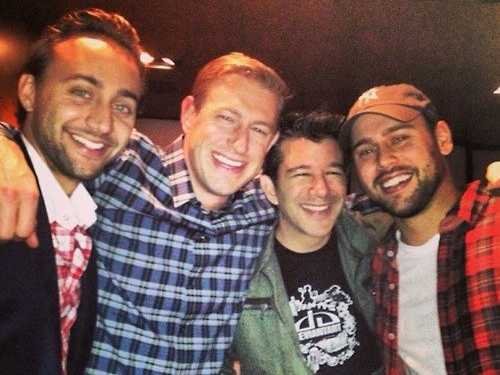
First business
At the age of 18, Kalanik launched the first business training courses for the SAT test “Academy of New Thinking”. SAT consists of three parts - mathematics, text analysis and grammar. For each, a maximum of 800 points was given, totaling 2,400 for three.
Kalanik claimed that the first student who completed his course of "1,500 or more" improved the result by 400 points. Kalanik himself scored 1580 in the first two parts. He was brought up by two questions on linguistics, writes Business Insider. In figures, as Kalanik likes to boast, he understands much better than in words, and can solve the mathematical part of SAT in eight minutes.
After graduating from high school, Kalanik entered programming at the University of California, Los Angeles, receiving almost maximum scores on the SAT.
First failure
At the university, he met with the first partners Michael Todd and Vince Busam, with whom he began work on Scour - a file sharing service. Sean Fanning, one of the first users of Scour, 18 months later launched a similar startup - Napster . Kalanik more than others was engaged in marketing and advertising. To promote the Scour Exchange (SX) product, he even hung a bottle of lubricant on the door handles of the dormitory rooms by sticking on them stickers with the Scour logo and the phrase “Don't open, SX works.”
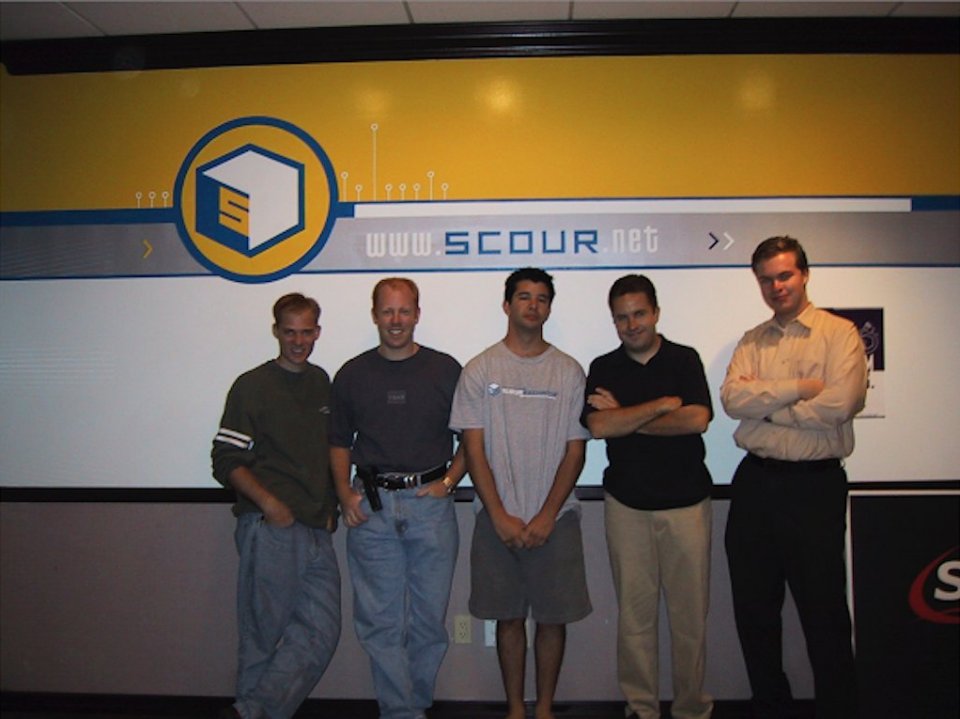
“Kalanik was negotiating so that everyone around forgot that he was only 20 years old,” says former Disney CEO Michael Ovitz, who bought 51% of Scour with billionaire Ron Burke. Later, watching Kalanik communicate with the authorities, Ovitz will say that the head of Uber is a man whom “you send to the ring and he always wins.”
Scour existed for three years, until it received a lawsuit from 30 major media companies accusing the service of copyright infringement in the amount of $ 250 billion. The company had to declare bankruptcy. Kalanik took this as a personal defeat and for a long time did not go to the cinema in order not to see the logo of Universal Pictures and other corporations that killed his brainchild on the screen.
RedSwoosh and Jam Pad
Speaking at the FailCon conference, where entrepreneurs talk about their failures, Kalanik announced a new project. A cunning plan for revenge on the "killers" of his past project was associated with him. The idea was to get 30 companies suing Scour to pay him. He hoped to distribute free or licensed content and receive money from every company that sued Scour. This is how the RedSwoosh file hosting service appeared - a service that allows you to cheaply transfer large files like large-quality photos and videos.
According to The Fortune, in the end, 23 out of 29 Scour-sued companies either became RedSwoosh clients, or periodically distributed their content with it. But soon Kalanik’s money ran out: he had nothing to even pay the salaries of seven employees.
In 2007, Akamai paid $ 23 million for RedSwoosh . With the proceeds, Kalanik bought a big house in San Francisco with a tennis court and a good view, called it Jam Pad and began to hold so-called jam sessions there, during which entrepreneurs discussed their ideas. Kalanik often hosted startups.
Offering his housing to the participants of the IT conference, he described it as “a place where entrepreneurs regularly hang out, express ideas and eat fantastic dishes prepared by the cook Jam Pad”. He invested a lot. “If Travis liked you, he invested in your company and helped for free,” recalls Greg Kretschmar: when he was looking for money for a Livefyre startup, Kalanik introduced it to 45 investors in less than a week and invested himself.
Uber
In 2008, Kalanik met at one of the conferences with the founder of the StumbleUpon service, Garret Camp. He told how in the New Year he hired a limousine with friends for $ 800 with friends. To Camp, the price seemed predatory. He came up with the idea to develop an application that would allow sharing the car with other comers from Silicon Valley.
In 2009, they, together with Kalanik, created Ubercab, a mobile application that allowed one-click calling of a personal driver. Then the service was used by friends in San Francisco, few people took it seriously. When Kamp asked Kalanik whether he would deal with him constantly, he answered in the negative - devoting himself to such an adventure was risky.
A year ago, founder Travis Kalanik was accused of stealing ideas and technologies. Allegedly, Kevin Halpern from California created a prototype of a service for ordering a taxi through a mobile application many years ago. The entrepreneur demanded compensation in the amount of one billion dollars.Ubercab argued a lot about the future. Some said that service should be focused on the luxury segment, adding the functions of ordering helicopters and airplanes. Others suggested making Ubercab massive, making it possible to drive expensive black cars cheaper than the overall market. So Kalanik thought. He reasoned: “The more people want to use this, the more drivers will be ready to provide such services. Competition will increase, cost will decrease, and the machine’s delivery time will decrease. ”
Halpern claimed that he developed his prototype back in 2002, at his company Celluride Wireless. They met Kalanik in 2006. Then Halpern and showed him his best practices. Kalanik allegedly used them to create his own project. Noteworthy is the mention of their re-meeting in 2008. It was then that he revealed to Kalanika the details of the project. And a year after that, the Uber service was launched. Representatives of the company are convinced that the claims are unfounded.
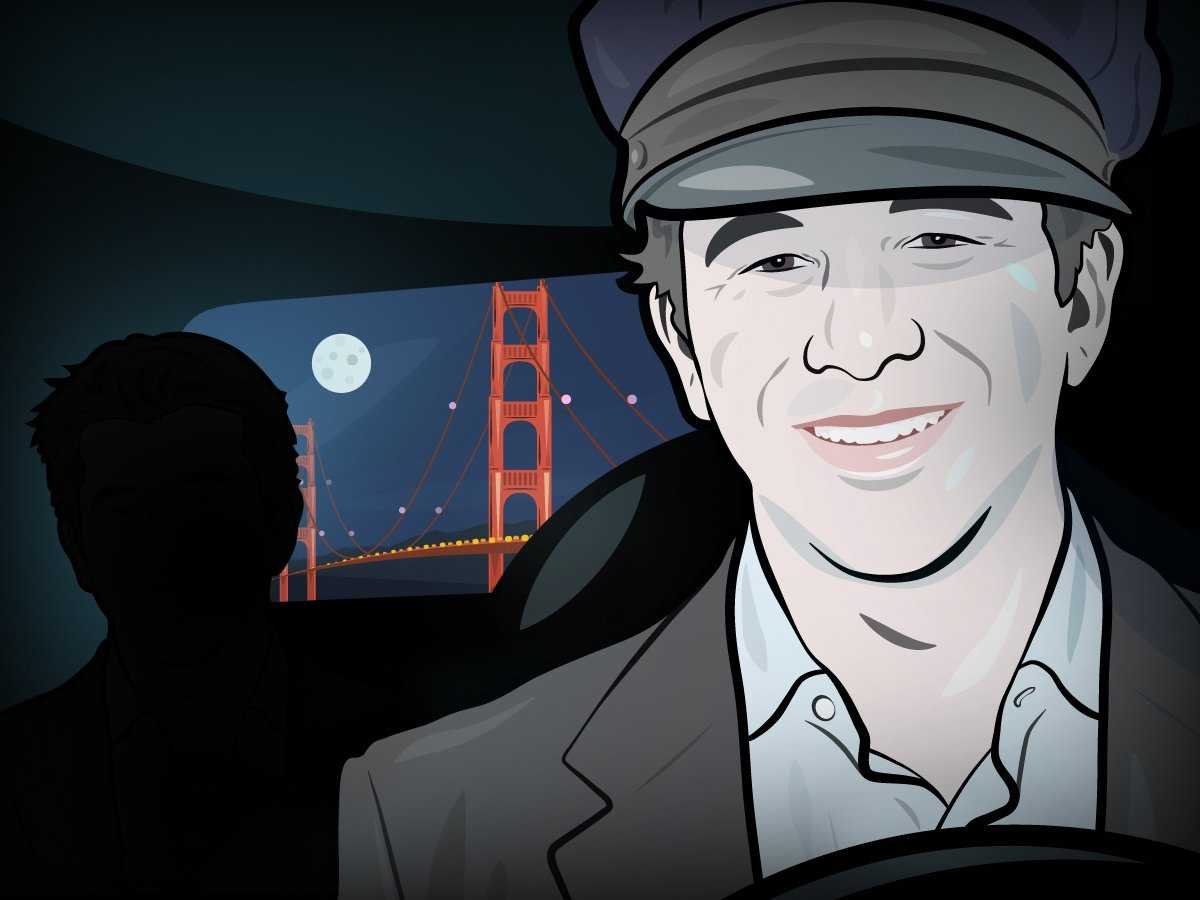
Travis Kalanick's parents were the first passengers of Uber to launch in Los Angeles.In October 2011, Kalanik attracted the attention of leading venture investors, including Netscape co-founder Mark Andrissen, who joined the board of directors of the service. Menlo Ventures' Sherwin Pishevar bought a stake and invested $ 20 million. Jeff Bezos, the head of Amazon, invested in the service. Uber began to use the Hollywood stars with which Kalanik was familiar: Ashton Kutcher, Jay Z, Edward Norton and others.
Thanks to this, Uber has become famous. For five years, the company received $ 8.21 billion from leading venture capital funds, hired 3,000 employees and opened offices in dozens of countries. Kalanik succeeded in what Facebook and Google failed to enter the Chinese market and gain an audience, despite the resistance of local players.
It's hard to get into Uber, but even harder to leave
Currently, Uber employs about 6,700 employees, and the number of people who have left in recent years is minimal by the standards of a large startup. The reason is simple - Uber has complicated the exit process for employees by issuing options for potentially large amounts.
For example, if you issue a 0.5% stake as a bonus at the start and subsequent investments in the region of $ 11 million, as well as an estimated value of $ 60 million as of 2011, this block of shares would cost $ 300 thousand. With an increase in capitalization to $ 60 billion, such a block of shares would rise in price to $ 299.7 million. But when leaving Uber, an employee is required to pay a tax of $ 119.8 million within 90 days. Moreover, the obligation to pay tax takes effect immediately after leaving Uber.
For its part, Uber imposes restrictions on the sale of shares in the third market, prohibiting their transfer to venture funds or private investors.
Earlier, Kalanik himself sold part of his shares to Uber. One of the journalists asked the entrepreneur if he was considering the possibility of selling the entire company. However, the Uber CEO said that the sale of part of the shares was planned as part of a startup development strategy.
“What kind of reaction do you expect if you ask a man who is happily married who will be his next wife?” The company founder asked a counter-question. “I had wives,” he continued with a smile. “But now I'm focused on just one (Uber), ” Kalanik said .
“Over the past 1.5 years, we have raised more than $ 10 billion, so we have the money. Our partners raise billions of dollars and go into debt. However, our task is to be disciplined when creating a business, ”he added.
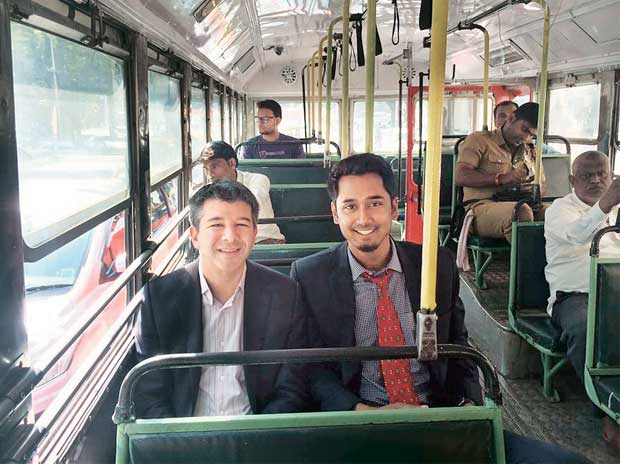
Leadership style
“I like to think of myself as Wolfe from Pulp Fiction,” Kalanik once told a group of Chicago entrepreneurs. He considers himself a cold and rational person who never stops.
Kalanik loves to argue. When CTO Uber Tuan Fam joined the company in 2012, Kalanik called him every day for two weeks in a row, asking him how best to communicate with the engineers. They debated a lot. As a result, Fam realized that Kalanik wants the employees to disagree with every his word, but to express their proposals. In the end, the best ideas win.
Kalanik claims to be running a fast-growing company with two lists. In one - the problems that need to be solved every day, in the other - the ideas that need to be implemented. Kalanik monitors all the details, but at the same time gives great freedom to managers. Every Monday, he meets with employees and talks about his immediate goals.
Personal life
Since 2015, Travis has been dating violinist and columnist Huffington Post Gabi Holzwart.
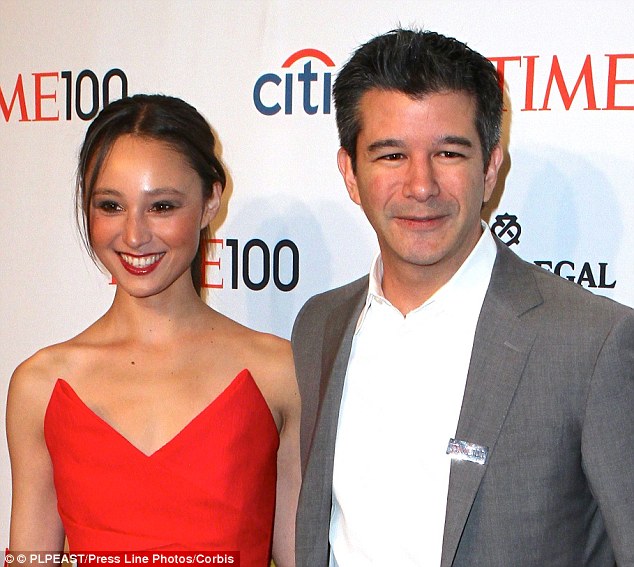
Personal qualities
"He is not sleeping. He does not lose focus. He sometimes even forgets that he is hungry. He tries again and again, inspiring others with his passion until the very end of the game. So, if Travis decided that he wants to make a cleaner, safer and easier taxi service than the one that is now, he will do the job. If he aimed at reforming a corrupt, pervasive and anti-consumer regulatory system, you will see that it will collapse soon, enthralling those who called it to life with their dishonest deals. If he wants to kill racism, which keeps people of different skin colors from gaining access to a taxi, he will achieve what he wants, ” writes his acquaintance, Chris Sacca, about Kalanika.
To him stubbornness knows no bounds. One day he spent nine hours in a row at the Google office, persuading one of the employees to go to him.
Kalanik has always been ambitious. This helped him to take the 13th place on Fortune's 40 to 40 entrepreneurs list at 37 : the publication called him “a rebel in the elite of Silicon Valley.”
“They ask me: things are going so well, do you feel great too? But my approach to life is such that I always gravitate towards some discomfort, ”Kalanik admitted.“ I always feel the same way I did 15 years ago. ”
Familiar Kalanika says duality is part of his character, and perhaps one of the reasons for his success. Ideology is inconsistency.
One night, he was waiting at the club for his friend Sean and had a fight with a guard. He asked him to leave. “I do not break the law,” Kalanik repeated, not moving. The guards called the police, Parker had to pay $ 2,000 to save a friend. In another Kalanik with RedSwoosh employees flew to Mexico. He got in a taxi, but decided that they wanted to cheat him, and refused to pay. The driver blocked the door, the entrepreneur had to jump out of the car on the go.
Founder Tips from Travis Kalanik
In January, The Secret of the Firm published fragments of a Kalanik lecture at the Indian Institute of Technology in Mumbai:
The essence of a startup is to constantly solve problems. That is why I love engineers so much - no one can overcome difficulties better than them. This is what they do every day: turn broken things into workable ones.
Entrepreneurs should be like mathematicians who love difficult tasks. Passion for finding and solving problems will turn you into a good entrepreneur.
Smart startupers know that even if their idea doesn’t work, there will be a thousand companies that will hire them, but they will still be better and smarter because they tried to do what no one tried.
You must not be a winner, but a champion.If you fall, rise again and again until you are successful. Failure is a state of mind. There was a period in my life when I failed for six years in a row, but every time I started all over again.
On the other hand, you need to be able to switch in time. If you spend all your strength in making the idea work, and in return receive only physical or emotional suffering and do not move forward at all, it is better to switch to something else.
Most people have good ideas, but they rarely implement them. Uber is a good idea. I don’t know if we were the first to invent it, but we were definitely the first to do it.
Do not wait for the investor to speak first.This is the worst possible deal. Think of your business as a chess game. You play chess 80 hours a week, so you constantly need to monitor the position of the pieces on the board and always be five to six times ahead of the opponent.
The main task of an entrepreneur is to become a chess expert and predict the moves of an opponent. In this case, when the investor offers you something, you will say: “This is interesting, but I can name 1800 reasons why this does not work. Here are 3,650 reasons for the right move. ”
If you do not know how to find a common language with people, you need to find a co-founder who can do this. If you are an introvert and cannot promote the project, find someone who can. If you are not energetic enough even to find an energetic person, it will be difficult for you.
The path of an entrepreneur is often associated with loneliness. Having a partner is very useful, especially in difficult times (which at first comes too often). The fun begins only after five years of hard work.
